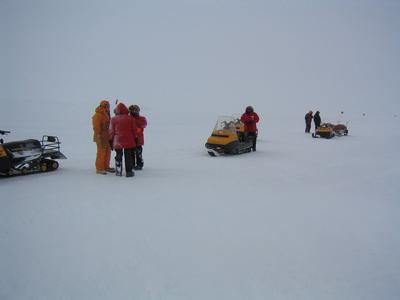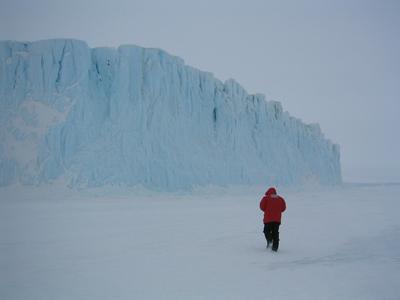15 November, 2002
Field trip back in time
Date: 11/15/02
Time of Log: 9 PM local time
Latitude: 77 degrees 51 minutes South
Longitude: 166 degrees 40 minutes East
Temperature: -12 C / +10 F
Wind speed: 11 knots
Wind Chill: -25 C / -13 F
Wind direction: East
Meters of ice collected: 0
Other data from this site:
Notes on daily Life:
Yesterday we had another waiting day here in McMurdo Station. The
weather had deteriorated enough so that flights both in and out were
cancelled. Unfortunately, it was just too cold and windy to go on our
outing to see the Penguin colonies at Cape Royds and the famous huts of
early explorers Scott and Shakelton. I was disappointed that we had to
postpone the field trip, but thankful for a day out of the wind and
cold. Gordon Hamilton and I discussed route planning and logistics came
up with the first of our web questions for our audience. How many
barrels of fuel will the team need to make the traverse? The answer ?
77.2 barrels of fuel are needed. But now for our second question, We
have had 76 barrels of fuel dropped in the field for our re-fueling
needs, do we have enough? How could this be?
This morning dawned partly cloudy, still cold and somewhat windy, but
this is a rugged group, so eight of us bundled up in our cold weather
gear and took off for a team field trip. Once again I found the
experience to be an educational one that helped me become better
prepared for the realities of our traverse to the South Pole.
Preparations for this day long snow mobile trip to a location about
thirteen miles from McMurdo included packing gear for overnight
survival, extra fuel for our five snowmobiles and enough hot cocoa and
snacks to keep us smiling! I was able to try out yet another clothing
combination and to learn how quickly the weather conditions can change
for the worse.
We got underway at about 10 am. Our little parade of five snowmobiles
headed for our first stop, Cape Evans. This is the site of one of Sir
Robert Scott?s huts. It is the one most commonly seen in photographs.
It is an awesome experience to have the opportunity to visit these
places and to stand in the same rooms that the explorers who came before
us stood in. I was impressed by how well preserved the place is. Being
there made me feel as if they had just stepped out for a moment and
would be back at any time, wondering whom this person in a huge red
parka was walking around in their hut. A very creepy feeling came over
me as I looked around. The beds look like they just stepped out of them
and the science benches are waiting patiently for their return with
samples from the field. Stores of food are on the shelves and empty cans
and boxes are stored just out side the door.
After about an hour's stop at this Cape Evans we reloaded our trusty
snowmobiles and zoomed off for our next vista, and enormous glacier
edge. This glacier is gigantic; it dwarfed us with its presence and
stunned us with its beauty. We gazed at it for a while and then moved
on to our final destination, Cape Royds, the site of another historic
hut and a large colony of Adelie Penguins.
By now the winds had picked up and it was getting even colder, but we
were determined to see the penguins and hut. One of my goals for this
trip was to see these adorable penguins. We parked our snowmobiles
carefully, remembering to face them into the wind and to check their
fuel levels before we headed off to see the Penguins. I practically ran
with excitement over the small hill that lay between the birds and me.
It?s pretty hard to run in the big blue boots, however finding the birds
is no problem, like any group of wild animals they have a strong smell.
The winds were howling, making it difficult to stand on the hilltop to
watch them, so we hid behind the rocks and silently watched these great
creatures. Many of the birds too, were hunkered down, out of the wind,
in small little balls of feathers. But many were up wandering about
setting up their nests or socializing with one another. We would have
stayed at this site much longer, but Paul recognized that the weather
was deteriorating further and we had better get started for home.
The third and final stop on our outing was a visit to one of Shakelton's
huts. This hut is also perfectly undisturbed. The sleeping bags of skin
are on the beds, the pots for boiling water on the stoves. We had a look
around this site and then began our long (one and one half-hour)
snowmobile ride home into the blowing winds and snow. We kept close
contact with one another as the weather came in around us reducing the
visibility to only twenty or thirty feet ahead of us. Several times we
stopped our progress and danced around to warm our hands and feet. As I
gazed at the scenery around us, and the lack thereof, I tried to imagine
how hard it must have been for the men who came to this place without
our modern means of travel or fancy clothing. Experiencing the cold and
wind while visiting these locations give us the chance to even more
deeply appreciate the drive and determination of these earliest
explorers. What courage they must have had in order to pursue science
and exploration in this harsh and unforgiving, but beautiful place.

Today's field trip team included; Paul, Susan, Betsy, Markus, Gordon, Jim, Mark and Steve. We were accompanied by Stacey from the science support staff here in McMurdo.

This stunning ice cliff could be seen on our way to Cape Evans.

The penguins at Cape Royds. These pictures were all taken by Markus Frey.

This is the lab bench left in Scott's hut. It is from the early 1900's things havent changed much in today's world.
Contact the TEA in the field at
.
If you cannot connect through your browser, copy the
TEA's e-mail address in the "To:" line of
your favorite e-mail package.
|
